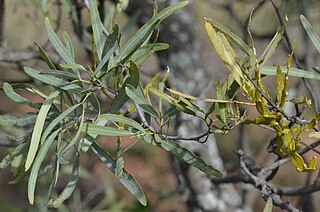
Loranthaceae, commonly known as the showy mistletoes, is a family of flowering plants. It consists of about 75 genera and 1,000 species of woody plants, many of them hemiparasites. The three terrestrial species are Nuytsia floribunda, Atkinsonia ligustrina, and Gaiadendron punctatum Loranthaceae are primarily xylem parasites, but their haustoria may sometimes tap the phloem, while Tristerix aphyllus is almost holoparasitic. For a more complete description of the Australian Loranthaceae, see Flora of Australia online., for the Malesian Loranthaceae see Flora of Malesia.

Misodendrum is a genus of hemiparasites which grow as mistletoes on various species of Nothofagus. Its species are all restricted to South America. The name of the genus is incorrectly spelt in a number of ways, including Misodendron and Myzodendron.

Loranthus is a genus of parasitic plants that grow on the branches of woody trees. It belongs to the family Loranthaceae, the showy mistletoe family. In most earlier systematic treatments it contains all mistletoe species with bisexual flowers, though some species have reversed to unisexual flowers. Other treatments restrict the genus to a few species. The systematic situation of Loranthus is not entirely clear.

Tapinanthus is a genus of mistletoe in the family Loranthaceae, endemic to Africa. The name of the genus is derived from the Greek tapeinos meaning "low" or "humble" and anthos meaning flower.

Amyema is a genus of semi-parasitic shrubs (mistletoes) which occur in Malesia and Australia.

Korthalsella is a genus of flowering plants in the sandalwood family, Santalaceae. It contains about 25 species distributed in Asia, Africa, Australia, and some Pacific Islands.

Lysiana is a genus of hemiparasitic shrubs endemic to Australia, in the family Loranthaceae.

Amyema quandang is a species of hemi-parasitic shrub which is widespread throughout the mainland of Australia, especially arid inland regions, sometimes referred to as the grey mistletoe.

Balanites is an Afrotropical, Palearctic and Indomalayan genus of flowering plants in the caltrop family, Zygophyllaceae. The name Balanites derives from the Greek word for an acorn and refers to the fruit, it was coined by Alire Delile in 1813.

Dendrophthoe is a genus of hemiparasitic shrubs found in Asia and Australia known as mistletoes. The genus was described by German naturalist Carl Friedrich Philipp von Martius in 1830.

Dendrophthoe vitellina, commonly known as long-flowered- or apostle mistletoe, is a hemiparasitic plant of the mistletoe family Loranthaceae. The genus Dendrophthoe comprises about 31 species spread across tropical Africa, Asia, and Australia. Despite being collected by Joseph Banks and Daniel Solander in 1788, and depicted in Banks' Florilegium, it was not until 1860 that it was described by Ferdinand von Mueller as Loranthus vitellinus after being collected near Ipswich, and renamed by Philippe Édouard Léon Van Tieghem in 1895.

Dendropemon is a genus of mistletoes which is endemic to the Caribbean. Members of the genus are hemi-parasites which normally grow on trees and shrubs, although self-parasitism is known to occur. The approximately 31 species range from The Bahamas and Cuba in the north and west, to Barbados and St. Vincent in the southwest. Diversity and endemism is highest on the island of Hispaniola.

Decaisnina is a genus of semi-parasitic shrubs (mistletoes) that occur in Australia. The type species is D. glauca. Around thirty species are known, found from northern Australia to Tahiti and the Philippines.

Muellerina is a genus of parasitic arial shrubs in the family Loranthaceae.

Taxillus is a plant genus in the mistletoe family: Loranthaceae.

Tristerix aphyllus is a holoparasitic plant species of the genus Tristerix in the family Loranthaceae. It is endemic to Chile. T. aphyllus is sometimes called the "cactus mistletoe." It should not be confused with the mistletoe cactus, which is an epiphytic cactus, and not a mistletoe.
Job Kuijt, is a Canadian botanist, with particular interest in Viscaceae, Loranthaceae and Eremolepidaceae

Amylotheca is a genus of hemi-parasitic arial shrubs in the family Loranthaceae, found in Borneo, Malaysia, New Caledonia, New Guinea, Australia, Sumatra, Thailand, and Vanuatu.

Korthalsella rubra is a flowering plant in the Santalaceae (sandalwood) family, formerly placed in the Viscaceae.
Phragmanthera is a genus of plants in the family Loranthaceae, the showy mistletoes. It is native to Africa and temperate Asia. The genus contains 35 species.


















